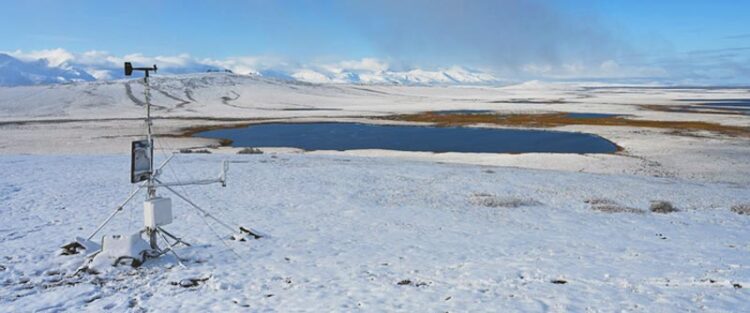Snow research fills gap in understanding Arctic climate

Statistical models based on several seasons of field research on the distribution of snow in Alaska are leading to a deeper understanding of changing hydrology, topography and vegetation dynamics in the Arctic and sub-Arctic.
Credit: Los Alamos National Laboratory
Modeling the way that snow distribution depends on terrain, elevation and vegetation will improve Earth-system models.
Comprehensive data from several seasons of field research in the Alaskan Arctic will address uncertainties in Earth-system and climate-change models about snow cover across the region and its impacts on water and the environment.
“Snow cover and its distribution affects not only the Arctic but global energy balances, and thus how it is changing is critically important for understanding how future global climate will shift,” said Katrina Bennett, lead author of the paper in The Cryosphere. Bennett is principal investigator at Los Alamos National Laboratory for the Department of Energy’s Next Generation Ecosystem Experiment Arctic project. “Our statistical model fills in the gap in understanding the spatial distribution of snow.”
The research found that spatial distribution depends most heavily on vegetation, elevation and landscape features, such as stream banks and benches — areas of topographic variability where shrubs grow and snow accumulates.
Based on random-forest machine learning, the statistical model characterizes the spatial pattern of the end-of-winter snow distribution and identifies the key factors controlling the spatial distribution. The model also predicts the snow distribution for the local study sites and can be generalized across the region.
Bennett said the analysis will be useful in validating physically based permafrost hydrology models, such as the Advanced Terrestrial Simulator developed at Los Alamos. The work will also help validate and provide improved snow redistribution representation in the land surface model within the Department of Energy’s Energy Exascale Earth System Model.
“Ultimately, it will increase our understanding of changing hydrology, topography and vegetation dynamics in the Arctic and sub-Arctic,” Bennett said.
Seasons in the snow
The multi-institutional research team, which included members from Los Alamos, University of Alaska Fairbanks, Lawrence Berkeley National Laboratory, Oak Ridge National Laboratory and University of Wisconsin–Madison, conducted snow surveys in the spring months of 2017–2019 at two small sites on the Seward Peninsula.
“We want to gratefully acknowledge Mary’s Igloo, Sitnasuak and Council Native Corporation for their guidance and for allowing us to conduct our research on their traditional lands,” Bennett said.
The field work focused on collecting end-of-winter snow-depth and snow-density measurements to calculate the amount of water contained within the snowpack. Those measurements characterize the impacts of snow cover on water and temperature better than snow-depth measurements do.
To create a model of snow distribution, the team estimated landscape factors for topography, vegetation and wind, and then quantified their impacts on snow distribution using three statistical models.
The Paper: Spatial Patterns of Snow Distribution in the sub-Arctic, in The Cryosphere, Katrina E. Bennett, Greta Miller, Robert Busey, Min Chen, Emma R. Lathrop, Julian B. Dann, Mara Nutt, Ryan Crumley, Shannon Dillard, Baptiste Dafflon, Jitendra Kumar, W. Robert Bolton, Cathy J. Wilson, Colleen Iverson, and Stan Wullschleger. https://tc.copernicus.org/articles/16/3269/2022/tc-16-3269-2022.html
The Funding: Department of Energy Office of Science, Office of Biological and Environmental Research through Next Generation Ecosystem Experiment (NGEE) Arctic project.
LA-UR-22-28580
Journal: The Cryosphere
DOI: 10.5194/tc-16-3269-2022
Method of Research: Observational study
Subject of Research: Not applicable
Article Title: Spatial patterns of snow distribution in the sub-Arctic
Article Publication Date: 17-Aug-2022
Media Contact
Charles Poling
DOE/Los Alamos National Laboratory
cpoling@lanl.gov
Cell: 505-257-8006
Original Source
All latest news from the category: Ecology, The Environment and Conservation
This complex theme deals primarily with interactions between organisms and the environmental factors that impact them, but to a greater extent between individual inanimate environmental factors.
innovations-report offers informative reports and articles on topics such as climate protection, landscape conservation, ecological systems, wildlife and nature parks and ecosystem efficiency and balance.
Newest articles

Properties of new materials for microchips
… can now be measured well. Reseachers of Delft University of Technology demonstrated measuring performance properties of ultrathin silicon membranes. Making ever smaller and more powerful chips requires new ultrathin…

Floating solar’s potential
… to support sustainable development by addressing climate, water, and energy goals holistically. A new study published this week in Nature Energy raises the potential for floating solar photovoltaics (FPV)…

Skyrmions move at record speeds
… a step towards the computing of the future. An international research team led by scientists from the CNRS1 has discovered that the magnetic nanobubbles2 known as skyrmions can be…





















